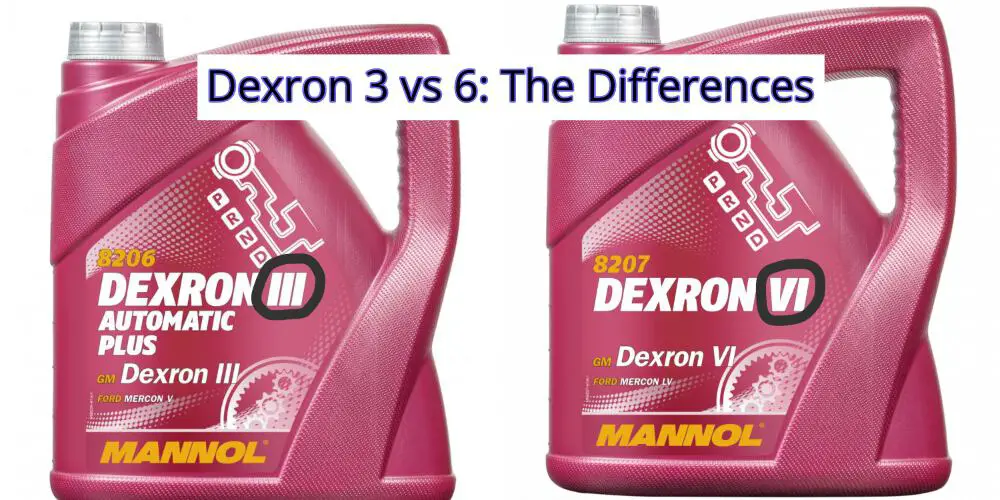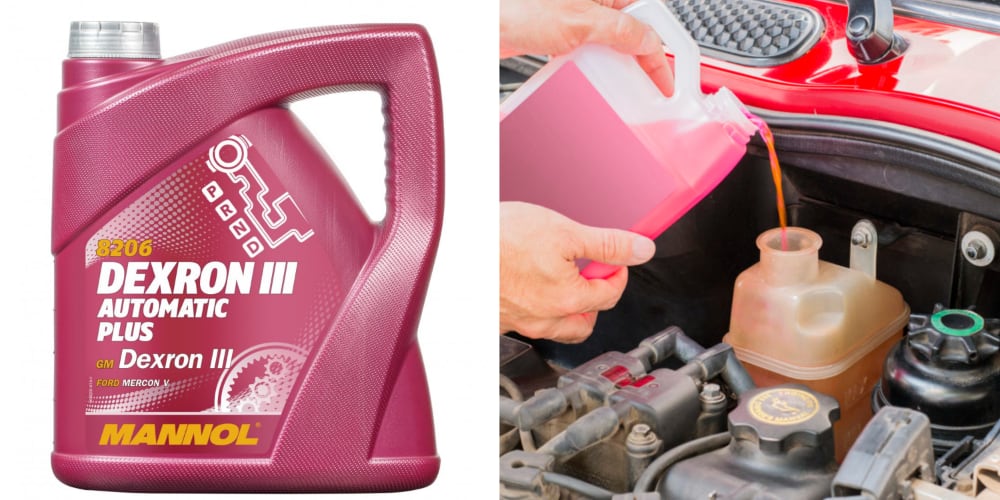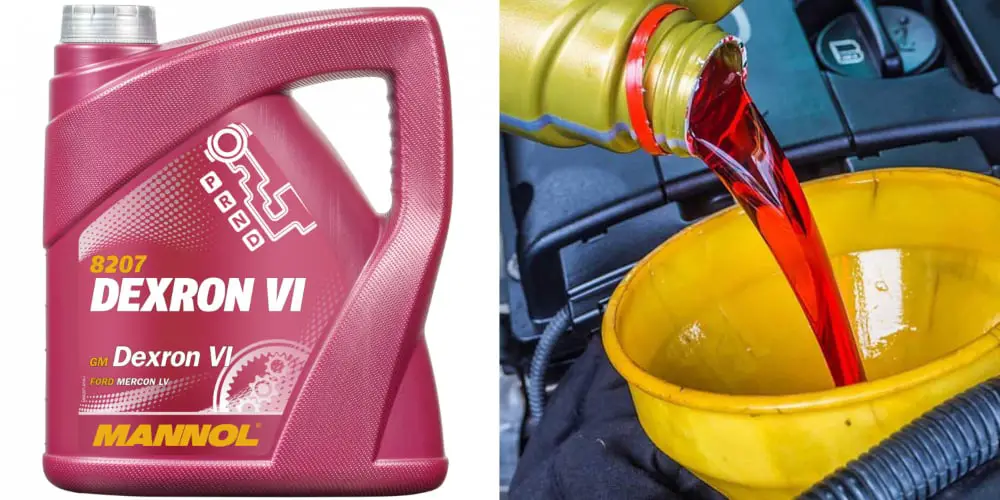
While the Dexron 3 and 6 are both reliable specifications, they have specific properties that make them preferable for particular engines and driving conditions.
No two fuel products are identical, and Dexron specifications are there for those who want only the best for their engine.
The Dexron 3 is a semi-synthetic fluid that offers good friction and oxidation stability and is often used for older vehicles. The Dexron 6, on the other hand, is a fully synthetic fluid offering good performance and long-lasting fluid life. Generally, the Dexron 6 is better.
Still, the two have similarities which I will also discuss in this article. After that, I’ll talk about the stand-out characteristics of the Dexron 3 and 6 so that you can make an informed decision on what type of transmission fuel to get for your car.
Without further ado, let’s get started!
Dexron 3 and 6: Basic Similarities
When you see the Dexron stamp on transmission fuel products, don’t assume that it’s a brand or product name.
Think of it like a Michelin Star but for fuel. This stamp lets you know that the transmission fuel has passed specific chemical standards.
Both Dexron 3 and 6 Are Synthetic
One of the many similarities between Dexron 3 and 6 is that they are both partly chemically engineered.
The Dexron 3 is semi-synthetic, while the Dexron 6 is fully synthetic. Because of chemical engineering, Dexron fluids have uniformly sized molecules.
Conventional oils, on the other hand, are composed of only refined petroleum, whose molecules may not be uniform in size.
Due to the molecule size uniformity, Dexron 3 and 6 can withstand higher temperatures and the most unforgiving engine conditions. This makes them much more reliable fuel overall.
Both Dexron 3 and 6 Offer High Lubrication
Another similarity is the extent of their lubrication. As transmission fluids, they are designed to quickly cover the complex gears of your engine in oil for optimum performance.
It is common for vehicles to experience shifts in driving conditions. As such, they must be prepared to accelerate and change gears when needed.
Quick gear shifts are attained through proper lubrication. It must be noted that all other transmission specifications, such as Mercon and Diamond, claim quick and high levels of lubrication, too.
If that’s the case, can you use Mercon and Diamond transmission fluids for vehicles that insist on using Dexron? No, you can’t. Some manufacturers design their transmission gear for certain fluids, like Ford, who insist that you use Mercon.
Both Dexron 3 and 6 Are Preferred for GM Vehicles
On the other hand, Honda and Toyota insist that you use their own transmission fluid. General Motors, meanwhile, highly advises you to use Dexron products on their engines, but it is also recommended for use with Kia, Nissan, and Opel.
You will also notice that Dexron 3 and 6 contain several additives that aim to clean engine pipelines and prolong engine life.
In fact, when the Dexron 3 was still the flagship specification of Dexron, it underwent several modifications to meet the changing engines of the 1990s to the early 2000s. It also did this to counter car owners’ many issues with their vehicles.
What Is the Dexron 3? Pros and Cons

The original version of the Dexron 3 came about in response to vehicles’ issues with the Dexron 2. Dexron 3 claimed to offer much more flexibility with different types of materials.
Here are the pros and cons of the Dexron 3:
Pros
- Good friction stability
- Good oxidation stability
- Good anti-acidic properties
- Cheaper than the Dexron 6
Cons
- May be considered obsolete
- Does not hold General Motors’ endorsement
- Still generally expensive
Dexron 3 Offers Friction and Oxidation Stability
As you can see from the list above, the Dexron 3 claims to offer better friction stability and oxidation stability. As you may know, the number one enemy of engine components is friction. The more the engine parts rub against each other, the more prone they are to corrosion.
Aside from this, the mixture of oxygen with your fuel is bound to cause chemical changes, which can also damage your vehicle. With the Dexron 3, it’s not much of a problem.
Another great thing about the Dexron 3 is its good Total Base Number (TBN). This means it can counter your engine’s acidic environment with the amount of basic compounds it has. Acids are quick to damage your engine components.
In 2005, both General Motors and Ford collaborated on a new transmission model. A new model required a new model type. This became the Dexron 6.
Dexron 3 Still Has a Demand Amongst Older Cars
Still, the Dexron 3 finds a present-day market amongst older cars that still require this particular formulation. While the Dexron 6 is backward compatible with the Dexron 3, General Motors highly advises against using it for vehicles that use the Dexron 3.
Dexron 3 Is Quite Expensive
For all the convenience and efficiency it offers, the Dexron 3 does come at a pretty high price. Still, the transmission part of your engine is among the most expensive and difficult to replace. If your car manufacturer recommends the Dexron 3, it’s best to adhere to this despite how expensive it is.
Do note that the General Motor licensing for the Dexron 3 expired in 2011. Still, many fluid manufacturers use the Dexron name, which General Motors does not endorse anymore.
What Is the Dexron 6? Pros and Cons

The Dexron 6, on the other hand, is a thinner and more advanced version of the Dexron 3.
Here are the general pros and cons of the Dexron 6:
Pros
- Is more compatible with modern vehicles
- Does not lose as much viscosity as the Dexron 3
- More efficient and more long-lasting fluid
- Better oxidative stability than the Dexron 3
- Better performance as a fully synthetic fluid
Cons
- Low biodegradability
- May cause leaking
- More expensive than the Dexron 3
Dexron 6 Is a More Long-Lasting Fluid
Usually, you would want thick viscosity for your transmission fluid. The Dexron 6 thins from 6.4 cSt at 100°C (212°F) to 5.5 cSt.
The thicker Dexron 3, on the other hand, thins from 7.5 cSt at 100°C (212°F) to 5.5 cSt. This means that despite the amount of shear stress in modern-day engines, the Dexron 6 doesn’t thin out as much as the Dexron 3. This makes it a more efficient and long-lasting fluid.
Dexron 6 Offers Much Better Performance
One of the stand-out components of the Dexron 6 is polyalphaolefin (PAO). The amount of PAO matches the oxidative stability found in the Dexron 3. PAO is also a stable compound and reacts quite positively to changes in the engine.
The Dexron 6 is also fully synthetic. This means that it can promise much better performance and better engine protection. This also means the Dexron 6 is more expensive than the 3.
With the Dexron 6, don’t expect sudden drops in quality, as this has been made to withstand even the most unforgiving engine conditions.
Dexron 6 Is Less Environmentally-Friendly
One drawback to the Dexron 6, however, is its low biodegradability. PAO is hard to decompose. PAO is also notorious for causing seals to shrink, so do expect leaks from time to time.
Finally, you can use the Dexron 6 in engines that generally require the Dexron 3.
Since Dexron isn’t necessarily a brand, many companies make products with the Dexron name. Here are my picks for the best Dexron 3 and Dexron 6 transmission fluids:
Best Dexron 3 ATF: Motul 10577 Dexron 3 ATF

This is probably one of the most well-rounded automatic transmission fluids on the market. It’s specifically geared to be anti-wear and anti-corrosion. It’s also compatible with vehicles both with the MERCON and the DEXRON standard.
It also stands out for its adaptability to cold temperatures due to its specialized Technosynthese technology. Even with high temperatures, the oil’s cling to your transmission’s components does not weather which is definitely what you want.
You can check the current price on Amazon here.
Best Dexron 6 ATF: ACDelco 10935 Dexron 6

This backward-compatible fuel provides your engine with optimum protection and nearly guarantees high-quality performance. The aeration in this variant is notable, and it also demonstrates good viscosity levels.
Expect very smooth gear shifts with this fluid and good fuel economy. This product also has good oxidation and friction stability and high fuel efficiency.
This means prolonged drain intervals! It being a Dexron 6 may set you back, but with all that it gives, it seems to be a worthy purchase!
You can check the current price on Amazon here.
Note: I am specifically discussing automatic transmission fluids. For manual transmissions, they have a different line of products altogether. This article elaborates on the distinction between the two.
Dexron 6 Is the Much Better Fluid
Being an improved version of the 3, the Dexron 6 is the superior fluid. It’s more efficient, performs better, and treats your engine better.
But, if you are instructed by your car manual to equip your engine with the Dexron 3, then you must comply with that.
Engine faults due to wrong fluids can be costly to correct.
Conclusion
Over the years, the Dexron series continues to abide by the rapidly changing technologies of the automotive industry, as shown in both the Dexron 3 and the 6.
While the 6 is generally superior, the 3 shouldn’t be disregarded altogether, as it’s still a noteworthy version of the Dexron that holds up in terms of fluid quality and offers competent transmission performance.
